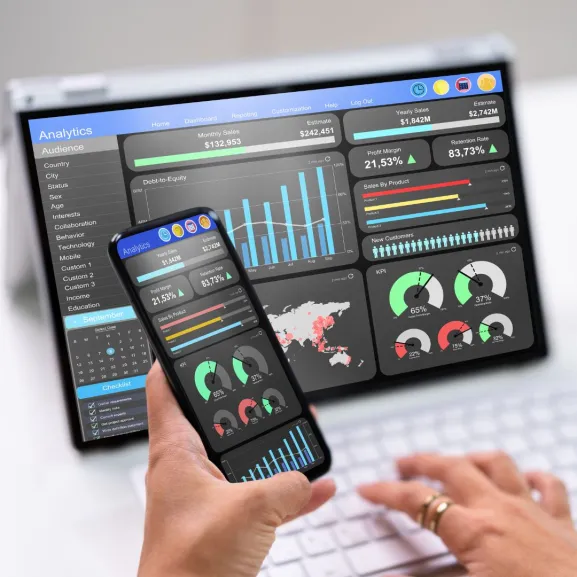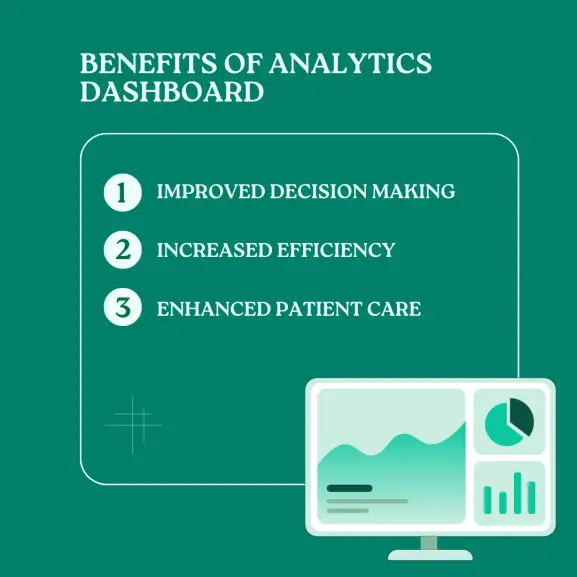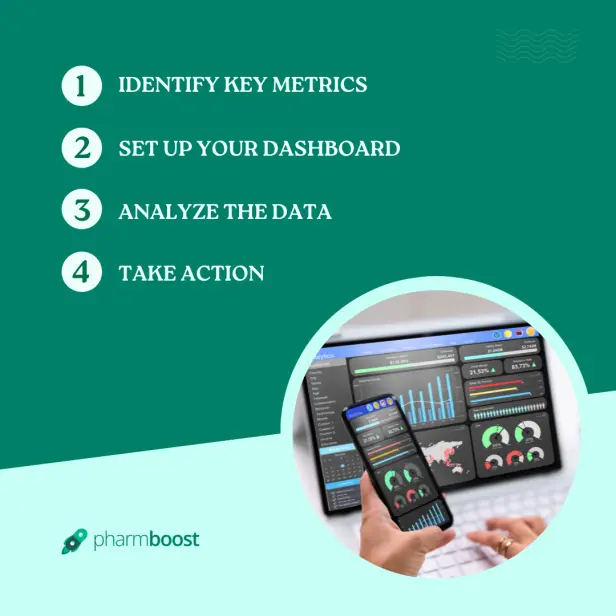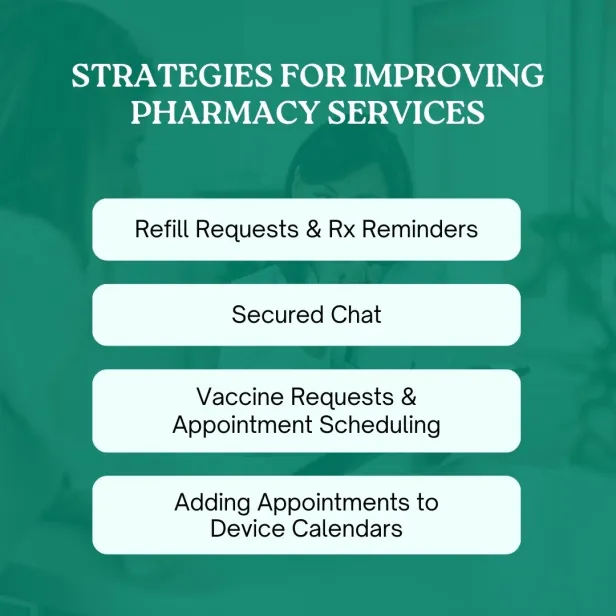Optimizing Operations: The Impact of an Analytics Dashboard for Pharmacies

In the rapidly evolving world of healthcare, independent pharmacies are constantly seeking ways to improve their operations and provide better services to their patients. One tool that has proven to be invaluable in this regard is the analytics dashboard.
This powerful tool provides a wealth of information that can help pharmacies make informed decisions. And thus they can improve overall performance.
The advent of digital technology has brought about a revolution in many industries, and healthcare is no exception.
Consequently, we now have access to a plethora of data that was previously unavailable or difficult to collect.
As a result, when this data is properly analysed and interpreted, it can offer valuable insights that have the potential to drive decision-making.
In the specific context of independent pharmacies, this data becomes particularly useful.
An analytics dashboard is essentially a data visualization tool that displays the current status of metrics and key performance indicators (KPIs) for an enterprise. The dashboards consolidate and arrange numbers, metrics and sometimes performance scorecards on a single screen. They may be tailored for a specific role and display metrics targeted for a single point of view or department. The essential features of a dashboard product include a customizable interface and the ability to pull real-time data from multiple sources.
Imagine being able to see at a glance how many prescriptions your pharmacy has filled in the past month, which medications are most commonly prescribed, or how many patients have been counseled on medication use. Imagine being able to track trends in medication use or identify areas where your pharmacy could improve its services. All of this is possible with an analytics dashboard.
But an analytics dashboard is more than just a tool for viewing data. It’s a decision-making aid. By providing real-time, relevant data in an easy-to-understand format, it allows pharmacy owners and managers to make informed decisions about their operations. It can help identify trends, spot problems before they become serious, and monitor the impact of changes in practice.
As we continue to move towards a more data-driven world, tools like this will become increasingly important in helping independent pharmacies stay competitive and provide the best possible care to their patients.
Importance of Analytics Dashboard
The importance of an analytics dashboard in a pharmacy setting cannot be overstated. It provides a centralized location where all relevant data can be viewed and analyzed. This includes data on sales, inventory, patient demographics, and more. By having all this information at their fingertips, pharmacies can make more informed decisions and identify areas where improvements can be made.
In the era of digital transformation, data has become the new oil. It is the driving force behind decision-making processes in various sectors, including healthcare. For independent pharmacies, the ability to harness this data effectively is crucial for their survival and growth. This is where an analytics dashboard comes into play.
An analytics dashboard serves as a single source of truth for pharmacies. It aggregates data from various sources into one platform, providing a holistic view of the pharmacy’s operations. This eliminates the need for manual data collection and analysis, saving time and reducing errors.
The dashboard provides real-time insights into key performance indicators (KPIs) such as sales trends, inventory turnover, and patient demographics. These insights enable pharmacies to monitor their performance continuously and make adjustments as necessary.
For instance, by analyzing sales data, pharmacies can identify which products are selling well and which are not. This information can guide purchasing decisions, helping to optimize inventory levels and reduce waste.
Similarly, by analyzing patient demographics, pharmacies can gain a better understanding of their customer base. This can inform marketing strategies and help to tailor services to meet the needs of different patient groups.
In essence, an analytics dashboard empowers pharmacies with data-driven insights, enabling them to make informed decisions that drive operational efficiency and improve patient care.
Benefits of Analytics Dashboard

There are numerous benefits to using an analytics dashboard in a pharmacy setting. Here are just a few:
- Improved Decision Making
With all relevant data readily available, pharmacies can make more informed decisions. This can lead to improved patient care, increased sales, and more efficient operations. - Increased Efficiency
By identifying trends and patterns in the data, pharmacies can streamline their operations. This can result in reduced waste, improved productivity, and increased profitability. - Enhanced Patient Care
With access to detailed patient data, pharmacies can provide personalized care. This can lead to improved patient satisfaction and loyalty.
The benefits of an analytics dashboard extend beyond these points. For instance, it promotes transparency by providing a clear view of the pharmacy’s operations. This transparency can build trust among stakeholders, including employees, patients, and regulatory bodies.
Moreover, an analytics dashboard fosters a culture of continuous improvement within the pharmacy. By regularly reviewing performance metrics, pharmacies can identify areas for improvement and take corrective action promptly.
In terms of patient care, an analytics dashboard allows pharmacies to deliver personalized services based on individual patient needs. For example, by analyzing prescription refill patterns, pharmacies can identify patients who may benefit from medication adherence programs.
Furthermore, an analytics dashboard supports strategic planning by providing valuable insights into market trends and competitive dynamics. Pharmacies can use this information to develop strategies that capitalize on opportunities and mitigate risks.
In conclusion, an analytics dashboard is not just a tool but a strategic asset for independent pharmacies. It provides actionable insights that drive decision-making, enhance operational efficiency, improve patient care, and ultimately contribute to the pharmacy’s bottom line.
How to Use Analytics Dashboard

Using an analytics dashboard is relatively straightforward, but to truly harness its power, one must understand the process and the potential that each step holds. Here are some steps to get you started:
- Identify Key Metrics
The first step in using an analytics dashboard effectively is to determine what data is most important to your pharmacy. This could include sales figures, inventory levels, patient demographics, etc. Each pharmacy may have different priorities and goals, and therefore, the key metrics may vary. For instance, a pharmacy focusing on improving patient care might prioritize metrics related to patient satisfaction and medication adherence. On the other hand, a pharmacy aiming to increase profitability might focus more on sales figures and inventory turnover rates. Identifying the right metrics is crucial as it sets the direction for your analysis and ensures that you are focusing on areas that align with your pharmacy’s goals. - Set Up Your Dashboard
Once you’ve identified your key metrics, the next step is to set up your dashboard to display this data. Most dashboards allow you to customize the layout and appearance to suit your needs. You can choose which metrics to display, how they should be presented (e.g., charts, graphs, tables), and where they should be placed on the dashboard. A well-designed dashboard not only makes it easier for you to access and interpret the data but also allows you to spot trends and patterns at a glance. Remember, the goal is not just to create a visually appealing dashboard but one that enhances your understanding of the data. - Analyze the Data
Regularly reviewing the data on your dashboard is crucial. Look for trends and patterns that could indicate areas for improvement. For example, if you notice a decline in sales of a particular product, it might indicate a decrease in demand or an issue with the product itself. Similarly, an increase in inventory levels might suggest overstocking or slow-moving items. Analyzing the data allows you to gain insights into your pharmacy’s operations and identify opportunities for improvement. - Take Action
The final step is perhaps the most important one - taking action based on your analysis. The insights gained from your analysis should guide your decision-making process and help you implement changes as needed. For instance, if your analysis reveals a high rate of medication non-adherence among patients, you might consider implementing a medication reminder system or conducting patient education sessions.
Remember, an analytics dashboard is not just about displaying data; it’s about turning that data into actionable insights. By identifying key metrics, setting up an effective dashboard, analyzing the data regularly, and taking informed actions, you can leverage the power of an analytics dashboard to drive improvements in your pharmacy’s operations and patient care.
Strategies for Improving Pharmacy Services

The use of an analytics dashboard can significantly enhance the services provided by independent pharmacies. Here are some strategies that can be implemented using insights gained from an analytics dashboard:
- Refill Requests & Rx Reminders
One of the key features of an analytics dashboard is the ability to analyze patient data. This data can be used to identify patients who may be due for a refill or who may benefit from medication reminders. For instance, if a patient has a chronic condition that requires regular medication, but the data shows inconsistent refill patterns, this could indicate a problem with medication adherence. In such cases, the pharmacy could set up automated reminders to help patients remember to refill their prescriptions. This not only improves patient health outcomes but also enhances customer loyalty and pharmacy revenues. - Secured Chat
Communication is a critical aspect of healthcare delivery. An analytics dashboard can facilitate this by integrating a secure chat feature. This feature allows pharmacists to communicate directly with patients, answer their queries, provide medication advice, and even remind them about their prescription refills. It adds a personal touch to the services and enhances patient satisfaction. - Order History
An analytics dashboard provides detailed insights into the order history. Pharmacies can use this data to anticipate future demand and manage inventory effectively. For instance, if certain medications show a consistent increase in demand during specific months, pharmacies can plan their inventory accordingly to avoid stock-outs and overstocking. - Vaccine Requests & Appointment Scheduling
The demographic data available on the analytics dashboard can be used to identify patients who may be eligible for certain vaccines or who may need to schedule regular appointments. Pharmacies can proactively reach out to these patients, inform them about the availability of vaccines, and help them schedule appointments. This proactive approach not only improves vaccination rates but also enhances patient engagement. - Adding Appointments to Device Calendars
In today’s digital age, most people rely on their device calendars for scheduling and reminders. Pharmacies can offer patients the option to add their appointments directly to their device calendars. This feature not only provides convenience to the patients but also improves appointment adherence.
One such platform that offers these features is Pharmboost. Pharmboost’s analytics dashboard provides independent pharmacies with real-time access to key metrics that drive decision-making processes within their operations. It offers features like refill requests & Rx reminders, secured chat, order history analysis, vaccine requests & appointment scheduling, and adding appointments to device calendars among others.
In conclusion, an analytics dashboard is a powerful tool that can transform the way independent pharmacies operate and deliver services. By leveraging data-driven insights from an analytics dashboard like Pharmboost’s, pharmacies can enhance their operational efficiency, improve patient care, and stay competitive in today’s dynamic healthcare landscape.
Conclusion
An analytics dashboard is indeed a powerful tool that can significantly enhance the operations of independent pharmacies. It provides invaluable insights into various aspects of pharmacy operations, enabling improved decision-making, increased efficiency, and enhanced patient care.
One such tool that has been making waves in the industry is Pharmboost. This unique patient engagement software is designed specifically for independent pharmacies and offers a plethora of features that align perfectly with the needs of today’s pharmacists.
Pharmboost’s features include appointment management, HIPAA compliant patient records, mobile access, and appointment scheduling. These features allow pharmacists to manage their time effectively, ensure patient privacy, and provide services to patients on the go.
Moreover, Pharmboost also offers a dashboard for easy management and tracking of patient history. This feature allows pharmacists to have a quick overview of a patient’s medication history, thereby enabling them to provide personalized care.
Another standout feature of Pharmboost is its patient medication messaging system. This allows pharmacists to remind patients about their medication on time, ensuring adherence to prescribed treatment plans.
Pharmboost also provides a secure platform for patient communications. With its multilingual chat feature, it allows pharmacists to answer patient queries and concerns in a timely and efficient manner.
Lastly, Pharmboost simplifies the process of prescription refills and transfers with its online refill & transfer prescription feature. This not only saves time for both the pharmacist and the patient but also ensures a seamless experience.
In conclusion, tools like Pharmboost are revolutionizing the way independent pharmacies operate. They not only streamline operations but also enhance the level of care provided to patients. So, dear pharmacists, embrace these technological advancements and witness your pharmacy grow!
Explore Benefits of using Pharmboost for your Pharmacy
Recent Post
- 5 Actionable Tips to Improve Patient Engagement within 1 Month
- Social Media Check List for Pharmacy Social Media Marketing
- Pharmacy Social Media Marketing 13 dos and don’ts to know
- Patient Engagement Barriers in Your Pharmacy & How Software Can Help You Overcome Them
- How to Attract New Patients and Boost Sales with Local Pharmacy Marketing







